Technological Unemployment and the Future of Work: SBM Group Report
VerifiedAdded on 2023/05/31
|9
|2382
|144
Report
AI Summary
This report examines the future of work, focusing on the concept of technological unemployment and its impact on the SBM group, a Mauritius banking company. It begins with an introduction to technological unemployment, where human labor is replaced by machines, and its implications for the banking sector. The report conducts a literature review, tracing the development of technological unemployment and its effects on organizations, highlighting the evolution of technology and its influence on the workforce. It then analyzes the specific impacts on the SBM group, including the introduction of digital banking, mobile banking, and automation, and discusses the advantages and disadvantages of these changes. The report applies Frey and Osborne's findings, exploring how job roles at high risk are being replaced by machines and the resulting changes within the SBM group. It concludes by summarizing the positive impacts of technology on the SBM group, such as increased productivity, reduced costs, and enhanced customer service, emphasizing the importance of adopting technology for business growth and competitiveness. The report utilizes various references to support its arguments and analysis.
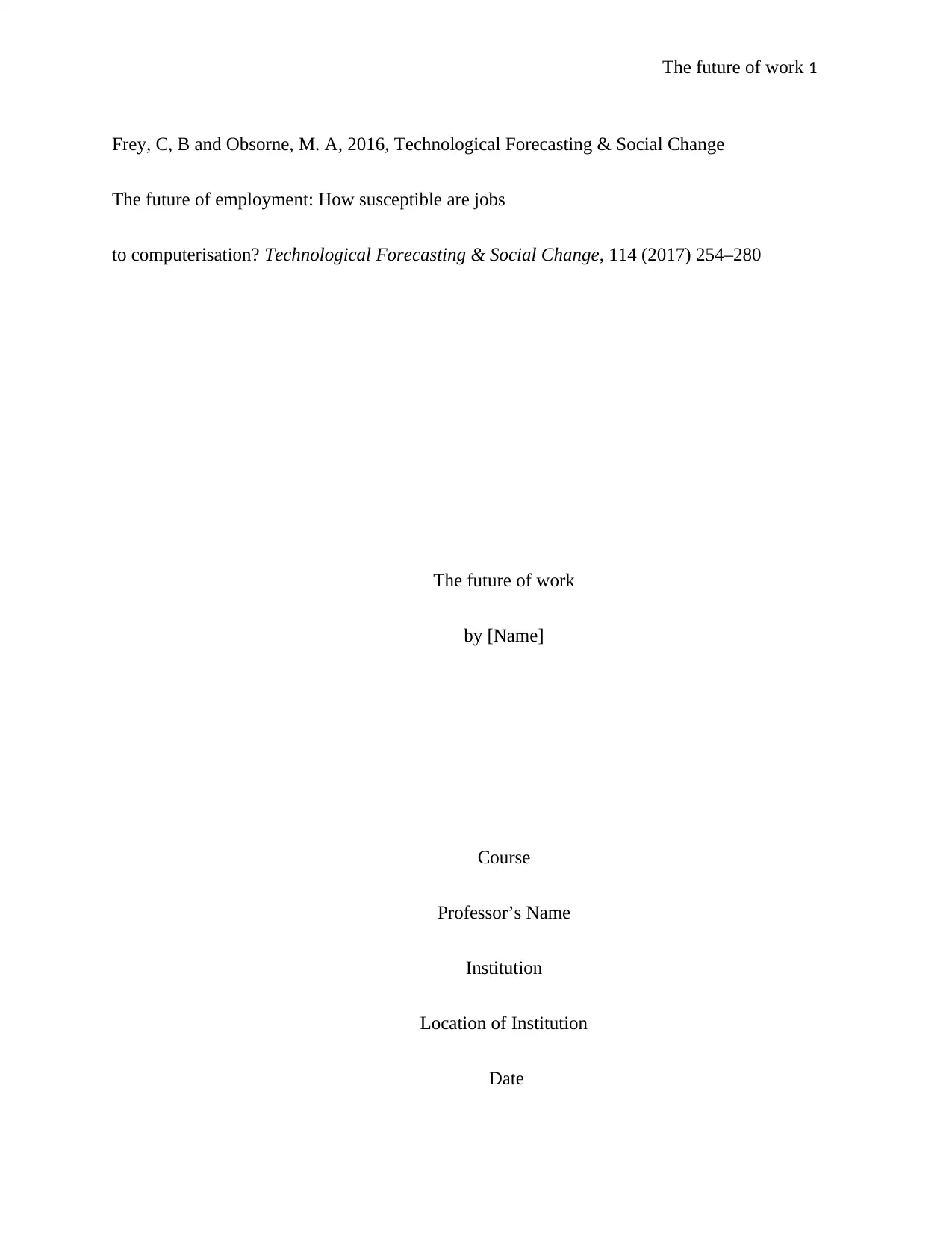
The future of work 1
Frey, C, B and Obsorne, M. A, 2016, Technological Forecasting & Social Change
The future of employment: How susceptible are jobs
to computerisation? Technological Forecasting & Social Change, 114 (2017) 254–280
The future of work
by [Name]
Course
Professor’s Name
Institution
Location of Institution
Date
Frey, C, B and Obsorne, M. A, 2016, Technological Forecasting & Social Change
The future of employment: How susceptible are jobs
to computerisation? Technological Forecasting & Social Change, 114 (2017) 254–280
The future of work
by [Name]
Course
Professor’s Name
Institution
Location of Institution
Date
Paraphrase This Document
Need a fresh take? Get an instant paraphrase of this document with our AI Paraphraser
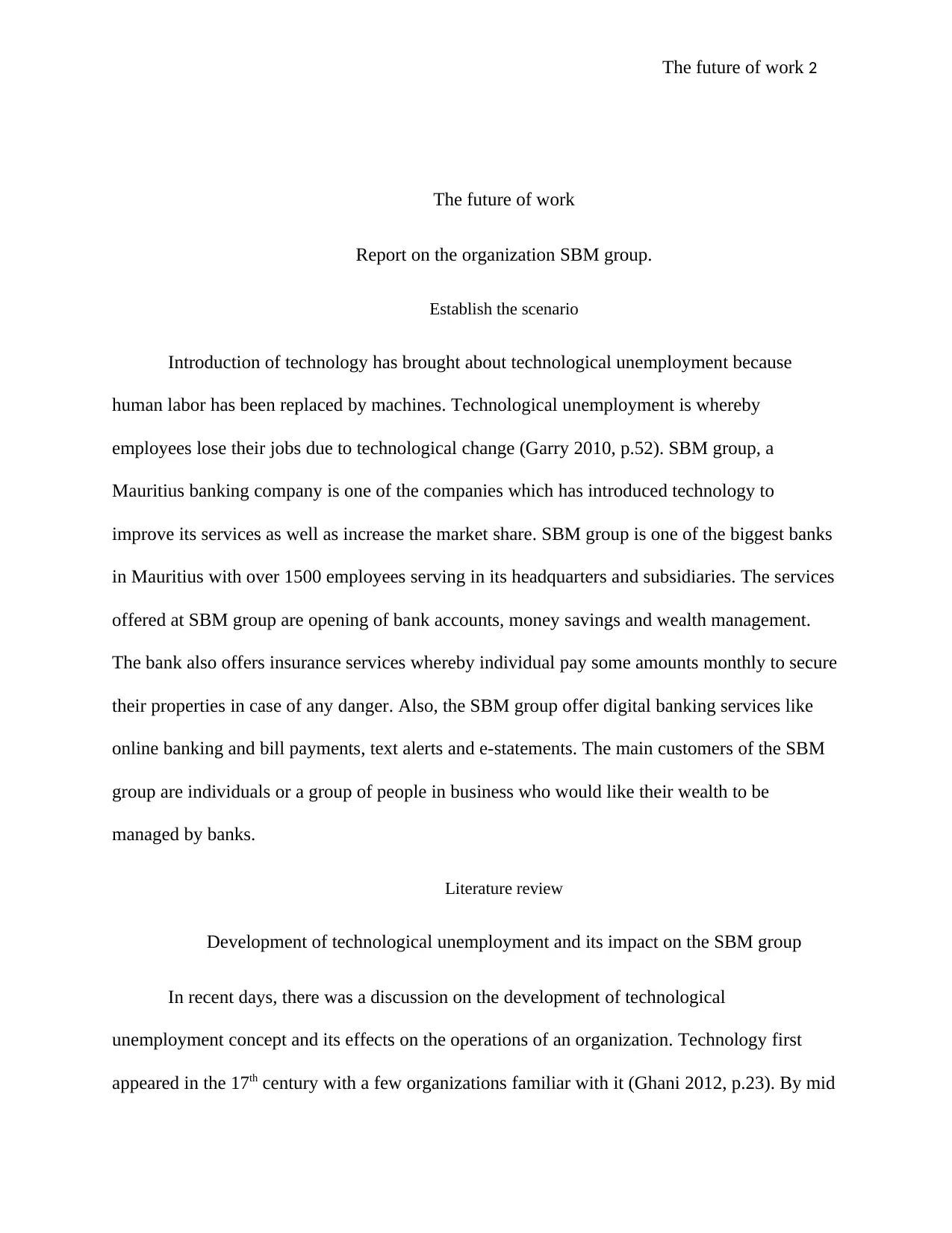
The future of work 2
The future of work
Report on the organization SBM group.
Establish the scenario
Introduction of technology has brought about technological unemployment because
human labor has been replaced by machines. Technological unemployment is whereby
employees lose their jobs due to technological change (Garry 2010, p.52). SBM group, a
Mauritius banking company is one of the companies which has introduced technology to
improve its services as well as increase the market share. SBM group is one of the biggest banks
in Mauritius with over 1500 employees serving in its headquarters and subsidiaries. The services
offered at SBM group are opening of bank accounts, money savings and wealth management.
The bank also offers insurance services whereby individual pay some amounts monthly to secure
their properties in case of any danger. Also, the SBM group offer digital banking services like
online banking and bill payments, text alerts and e-statements. The main customers of the SBM
group are individuals or a group of people in business who would like their wealth to be
managed by banks.
Literature review
Development of technological unemployment and its impact on the SBM group
In recent days, there was a discussion on the development of technological
unemployment concept and its effects on the operations of an organization. Technology first
appeared in the 17th century with a few organizations familiar with it (Ghani 2012, p.23). By mid
The future of work
Report on the organization SBM group.
Establish the scenario
Introduction of technology has brought about technological unemployment because
human labor has been replaced by machines. Technological unemployment is whereby
employees lose their jobs due to technological change (Garry 2010, p.52). SBM group, a
Mauritius banking company is one of the companies which has introduced technology to
improve its services as well as increase the market share. SBM group is one of the biggest banks
in Mauritius with over 1500 employees serving in its headquarters and subsidiaries. The services
offered at SBM group are opening of bank accounts, money savings and wealth management.
The bank also offers insurance services whereby individual pay some amounts monthly to secure
their properties in case of any danger. Also, the SBM group offer digital banking services like
online banking and bill payments, text alerts and e-statements. The main customers of the SBM
group are individuals or a group of people in business who would like their wealth to be
managed by banks.
Literature review
Development of technological unemployment and its impact on the SBM group
In recent days, there was a discussion on the development of technological
unemployment concept and its effects on the operations of an organization. Technology first
appeared in the 17th century with a few organizations familiar with it (Ghani 2012, p.23). By mid
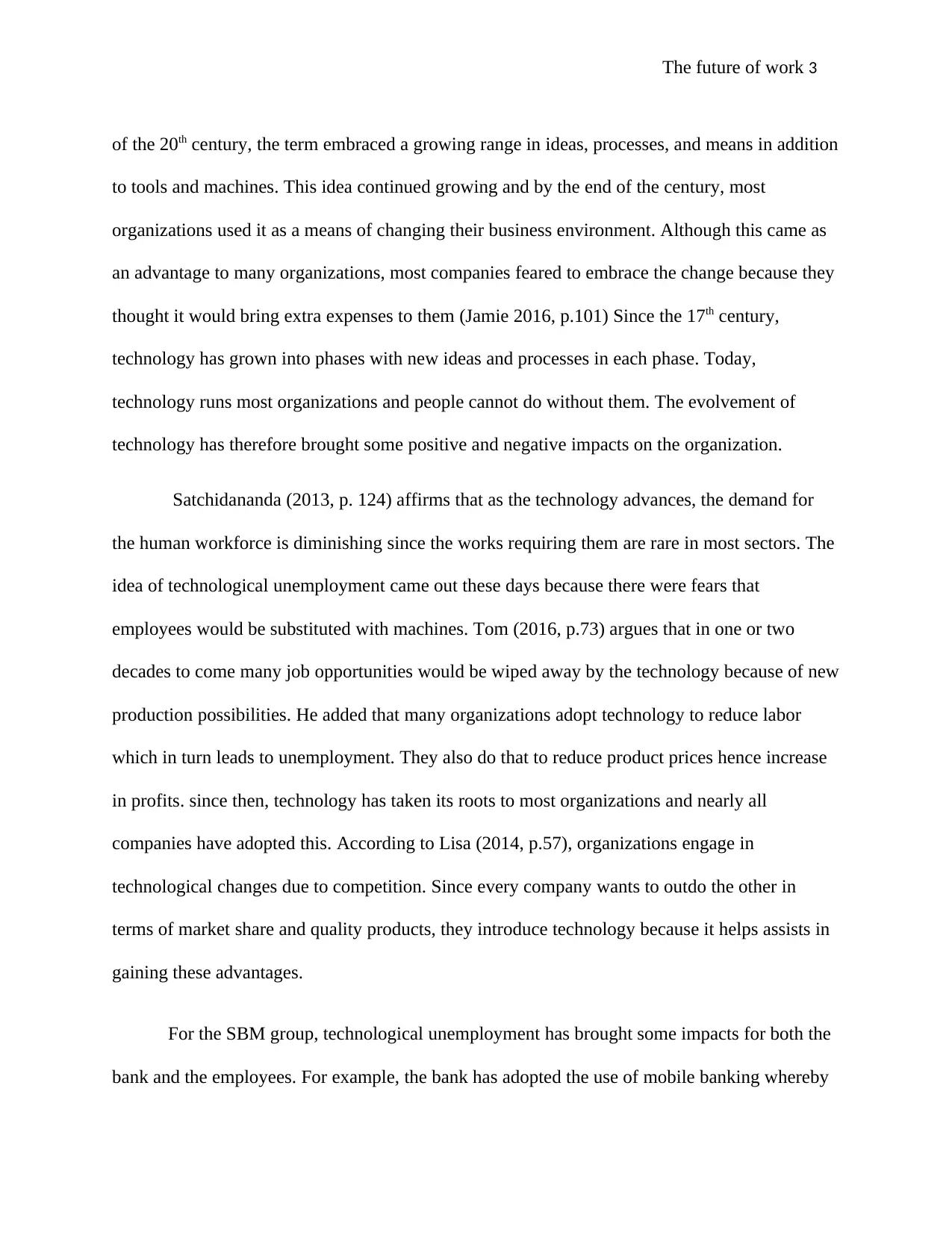
The future of work 3
of the 20th century, the term embraced a growing range in ideas, processes, and means in addition
to tools and machines. This idea continued growing and by the end of the century, most
organizations used it as a means of changing their business environment. Although this came as
an advantage to many organizations, most companies feared to embrace the change because they
thought it would bring extra expenses to them (Jamie 2016, p.101) Since the 17th century,
technology has grown into phases with new ideas and processes in each phase. Today,
technology runs most organizations and people cannot do without them. The evolvement of
technology has therefore brought some positive and negative impacts on the organization.
Satchidananda (2013, p. 124) affirms that as the technology advances, the demand for
the human workforce is diminishing since the works requiring them are rare in most sectors. The
idea of technological unemployment came out these days because there were fears that
employees would be substituted with machines. Tom (2016, p.73) argues that in one or two
decades to come many job opportunities would be wiped away by the technology because of new
production possibilities. He added that many organizations adopt technology to reduce labor
which in turn leads to unemployment. They also do that to reduce product prices hence increase
in profits. since then, technology has taken its roots to most organizations and nearly all
companies have adopted this. According to Lisa (2014, p.57), organizations engage in
technological changes due to competition. Since every company wants to outdo the other in
terms of market share and quality products, they introduce technology because it helps assists in
gaining these advantages.
For the SBM group, technological unemployment has brought some impacts for both the
bank and the employees. For example, the bank has adopted the use of mobile banking whereby
of the 20th century, the term embraced a growing range in ideas, processes, and means in addition
to tools and machines. This idea continued growing and by the end of the century, most
organizations used it as a means of changing their business environment. Although this came as
an advantage to many organizations, most companies feared to embrace the change because they
thought it would bring extra expenses to them (Jamie 2016, p.101) Since the 17th century,
technology has grown into phases with new ideas and processes in each phase. Today,
technology runs most organizations and people cannot do without them. The evolvement of
technology has therefore brought some positive and negative impacts on the organization.
Satchidananda (2013, p. 124) affirms that as the technology advances, the demand for
the human workforce is diminishing since the works requiring them are rare in most sectors. The
idea of technological unemployment came out these days because there were fears that
employees would be substituted with machines. Tom (2016, p.73) argues that in one or two
decades to come many job opportunities would be wiped away by the technology because of new
production possibilities. He added that many organizations adopt technology to reduce labor
which in turn leads to unemployment. They also do that to reduce product prices hence increase
in profits. since then, technology has taken its roots to most organizations and nearly all
companies have adopted this. According to Lisa (2014, p.57), organizations engage in
technological changes due to competition. Since every company wants to outdo the other in
terms of market share and quality products, they introduce technology because it helps assists in
gaining these advantages.
For the SBM group, technological unemployment has brought some impacts for both the
bank and the employees. For example, the bank has adopted the use of mobile banking whereby
⊘ This is a preview!⊘
Do you want full access?
Subscribe today to unlock all pages.

Trusted by 1+ million students worldwide
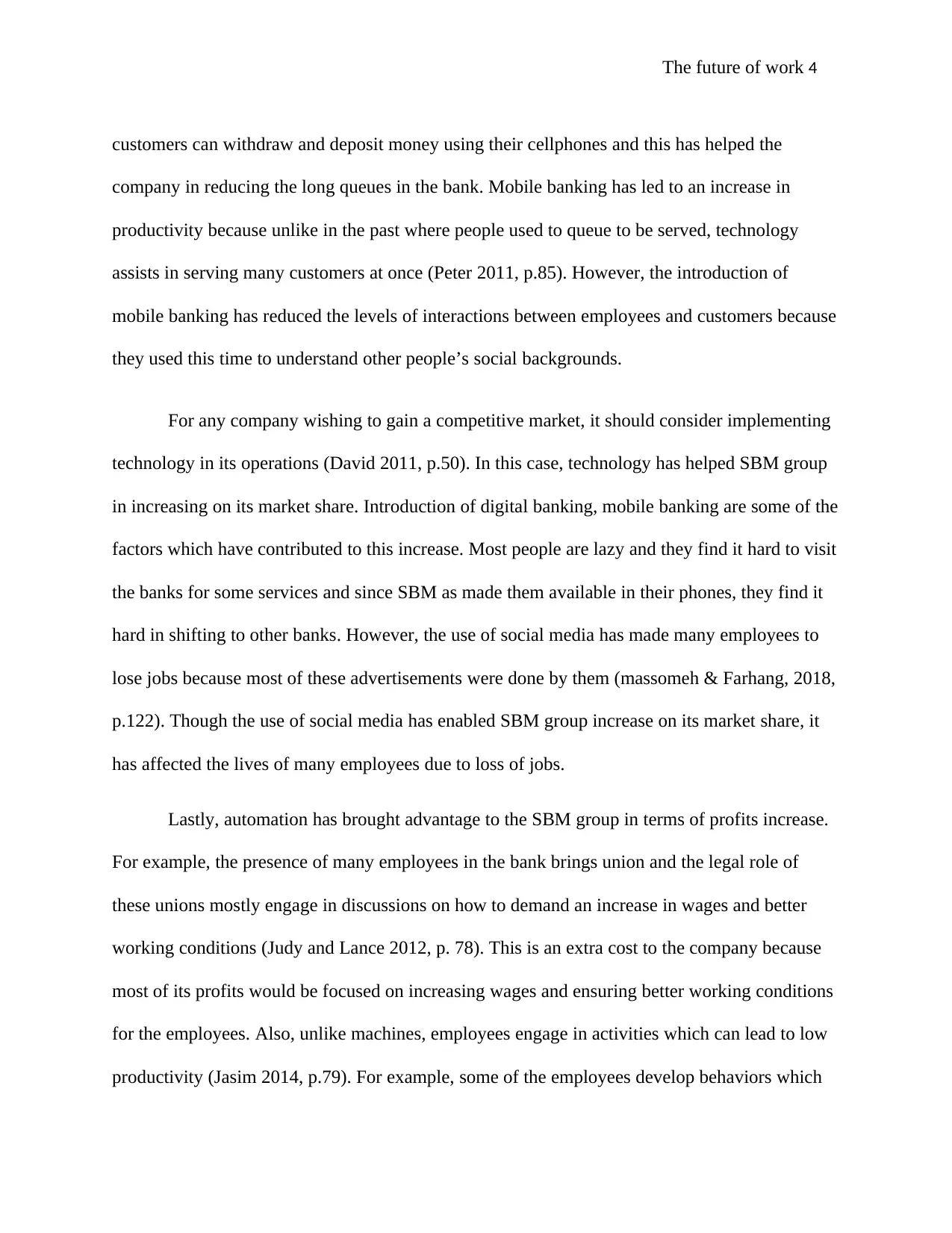
The future of work 4
customers can withdraw and deposit money using their cellphones and this has helped the
company in reducing the long queues in the bank. Mobile banking has led to an increase in
productivity because unlike in the past where people used to queue to be served, technology
assists in serving many customers at once (Peter 2011, p.85). However, the introduction of
mobile banking has reduced the levels of interactions between employees and customers because
they used this time to understand other people’s social backgrounds.
For any company wishing to gain a competitive market, it should consider implementing
technology in its operations (David 2011, p.50). In this case, technology has helped SBM group
in increasing on its market share. Introduction of digital banking, mobile banking are some of the
factors which have contributed to this increase. Most people are lazy and they find it hard to visit
the banks for some services and since SBM as made them available in their phones, they find it
hard in shifting to other banks. However, the use of social media has made many employees to
lose jobs because most of these advertisements were done by them (massomeh & Farhang, 2018,
p.122). Though the use of social media has enabled SBM group increase on its market share, it
has affected the lives of many employees due to loss of jobs.
Lastly, automation has brought advantage to the SBM group in terms of profits increase.
For example, the presence of many employees in the bank brings union and the legal role of
these unions mostly engage in discussions on how to demand an increase in wages and better
working conditions (Judy and Lance 2012, p. 78). This is an extra cost to the company because
most of its profits would be focused on increasing wages and ensuring better working conditions
for the employees. Also, unlike machines, employees engage in activities which can lead to low
productivity (Jasim 2014, p.79). For example, some of the employees develop behaviors which
customers can withdraw and deposit money using their cellphones and this has helped the
company in reducing the long queues in the bank. Mobile banking has led to an increase in
productivity because unlike in the past where people used to queue to be served, technology
assists in serving many customers at once (Peter 2011, p.85). However, the introduction of
mobile banking has reduced the levels of interactions between employees and customers because
they used this time to understand other people’s social backgrounds.
For any company wishing to gain a competitive market, it should consider implementing
technology in its operations (David 2011, p.50). In this case, technology has helped SBM group
in increasing on its market share. Introduction of digital banking, mobile banking are some of the
factors which have contributed to this increase. Most people are lazy and they find it hard to visit
the banks for some services and since SBM as made them available in their phones, they find it
hard in shifting to other banks. However, the use of social media has made many employees to
lose jobs because most of these advertisements were done by them (massomeh & Farhang, 2018,
p.122). Though the use of social media has enabled SBM group increase on its market share, it
has affected the lives of many employees due to loss of jobs.
Lastly, automation has brought advantage to the SBM group in terms of profits increase.
For example, the presence of many employees in the bank brings union and the legal role of
these unions mostly engage in discussions on how to demand an increase in wages and better
working conditions (Judy and Lance 2012, p. 78). This is an extra cost to the company because
most of its profits would be focused on increasing wages and ensuring better working conditions
for the employees. Also, unlike machines, employees engage in activities which can lead to low
productivity (Jasim 2014, p.79). For example, some of the employees develop behaviors which
Paraphrase This Document
Need a fresh take? Get an instant paraphrase of this document with our AI Paraphraser

The future of work 5
can bring about poor work relationship between the workers. A poor work relationship is one of
the major cause of low productivity.
Applying Frey and Osborne’s findings
Changes to the SBM group when jobs at high risk are replaced by machines
Frey and Osborne (2016, P. 258) discussed some of the impacts of technological
unemployment in the company. They argued that it is hard to talk against automation because it
is clearly shown in most companies that replacing jobs with technology has led to an increase in
productivity. Replacing the jobs at high risks has enabled SBM group to improve its ways of
communication. For example, the bank is able to communicate of the new services to its
customers in a more simple and fast way. Communication, in this case, is done through
Facebook, Twitter and any other form of social media. The bank does not incur costs of making
brochures. The managers would also be able to get feedback from the customers about their
services. They use these opinions in their planning process to improve the quality of services
hence meeting the customers’ requirements.
Also, SBM group managers use social media platforms to communicate with their
employees about their roles in the company. They mostly use emails and websites to
communicate the important issues within the company (Frey and Obsorne 2016 P. 257). This has
reduced the time set for meetings which they use it in doing other important things necessary for
the company progress. They also use these social media platforms to warn employees of their
negative behaviors which can make them not perform well (Peter 2011, p.90). This is mostly
done through employee’s personal emails and it is important because once an employee receives
can bring about poor work relationship between the workers. A poor work relationship is one of
the major cause of low productivity.
Applying Frey and Osborne’s findings
Changes to the SBM group when jobs at high risk are replaced by machines
Frey and Osborne (2016, P. 258) discussed some of the impacts of technological
unemployment in the company. They argued that it is hard to talk against automation because it
is clearly shown in most companies that replacing jobs with technology has led to an increase in
productivity. Replacing the jobs at high risks has enabled SBM group to improve its ways of
communication. For example, the bank is able to communicate of the new services to its
customers in a more simple and fast way. Communication, in this case, is done through
Facebook, Twitter and any other form of social media. The bank does not incur costs of making
brochures. The managers would also be able to get feedback from the customers about their
services. They use these opinions in their planning process to improve the quality of services
hence meeting the customers’ requirements.
Also, SBM group managers use social media platforms to communicate with their
employees about their roles in the company. They mostly use emails and websites to
communicate the important issues within the company (Frey and Obsorne 2016 P. 257). This has
reduced the time set for meetings which they use it in doing other important things necessary for
the company progress. They also use these social media platforms to warn employees of their
negative behaviors which can make them not perform well (Peter 2011, p.90). This is mostly
done through employee’s personal emails and it is important because once an employee receives
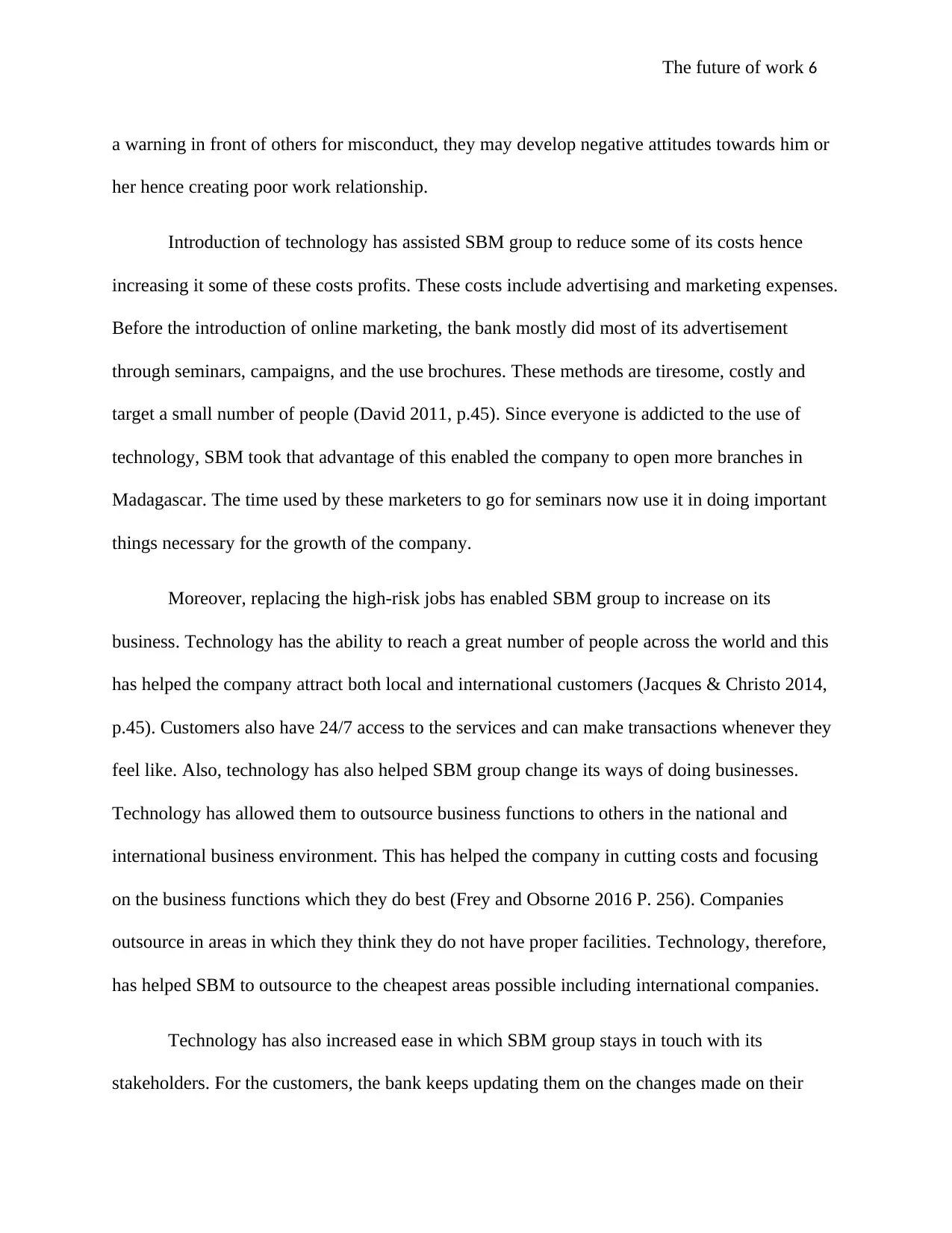
The future of work 6
a warning in front of others for misconduct, they may develop negative attitudes towards him or
her hence creating poor work relationship.
Introduction of technology has assisted SBM group to reduce some of its costs hence
increasing it some of these costs profits. These costs include advertising and marketing expenses.
Before the introduction of online marketing, the bank mostly did most of its advertisement
through seminars, campaigns, and the use brochures. These methods are tiresome, costly and
target a small number of people (David 2011, p.45). Since everyone is addicted to the use of
technology, SBM took that advantage of this enabled the company to open more branches in
Madagascar. The time used by these marketers to go for seminars now use it in doing important
things necessary for the growth of the company.
Moreover, replacing the high-risk jobs has enabled SBM group to increase on its
business. Technology has the ability to reach a great number of people across the world and this
has helped the company attract both local and international customers (Jacques & Christo 2014,
p.45). Customers also have 24/7 access to the services and can make transactions whenever they
feel like. Also, technology has also helped SBM group change its ways of doing businesses.
Technology has allowed them to outsource business functions to others in the national and
international business environment. This has helped the company in cutting costs and focusing
on the business functions which they do best (Frey and Obsorne 2016 P. 256). Companies
outsource in areas in which they think they do not have proper facilities. Technology, therefore,
has helped SBM to outsource to the cheapest areas possible including international companies.
Technology has also increased ease in which SBM group stays in touch with its
stakeholders. For the customers, the bank keeps updating them on the changes made on their
a warning in front of others for misconduct, they may develop negative attitudes towards him or
her hence creating poor work relationship.
Introduction of technology has assisted SBM group to reduce some of its costs hence
increasing it some of these costs profits. These costs include advertising and marketing expenses.
Before the introduction of online marketing, the bank mostly did most of its advertisement
through seminars, campaigns, and the use brochures. These methods are tiresome, costly and
target a small number of people (David 2011, p.45). Since everyone is addicted to the use of
technology, SBM took that advantage of this enabled the company to open more branches in
Madagascar. The time used by these marketers to go for seminars now use it in doing important
things necessary for the growth of the company.
Moreover, replacing the high-risk jobs has enabled SBM group to increase on its
business. Technology has the ability to reach a great number of people across the world and this
has helped the company attract both local and international customers (Jacques & Christo 2014,
p.45). Customers also have 24/7 access to the services and can make transactions whenever they
feel like. Also, technology has also helped SBM group change its ways of doing businesses.
Technology has allowed them to outsource business functions to others in the national and
international business environment. This has helped the company in cutting costs and focusing
on the business functions which they do best (Frey and Obsorne 2016 P. 256). Companies
outsource in areas in which they think they do not have proper facilities. Technology, therefore,
has helped SBM to outsource to the cheapest areas possible including international companies.
Technology has also increased ease in which SBM group stays in touch with its
stakeholders. For the customers, the bank keeps updating them on the changes made on their
⊘ This is a preview!⊘
Do you want full access?
Subscribe today to unlock all pages.

Trusted by 1+ million students worldwide

The future of work 7
services or existence of a new form of services. Also, if the customers are facing any kind of
dissatisfaction they keep updating the management to make the right thing. Moreover, employees
can sort for an assistance from their college even if they are out of their reach (Amber 2018,
p.100). This can be done through text message or a video chat. Technology has literally changed
on how business operates and never before in history has that change occurred so fast. It is
therefore concluded that any business aspiring to grow it should introduce technology in its
operations.
services or existence of a new form of services. Also, if the customers are facing any kind of
dissatisfaction they keep updating the management to make the right thing. Moreover, employees
can sort for an assistance from their college even if they are out of their reach (Amber 2018,
p.100). This can be done through text message or a video chat. Technology has literally changed
on how business operates and never before in history has that change occurred so fast. It is
therefore concluded that any business aspiring to grow it should introduce technology in its
operations.
Paraphrase This Document
Need a fresh take? Get an instant paraphrase of this document with our AI Paraphraser
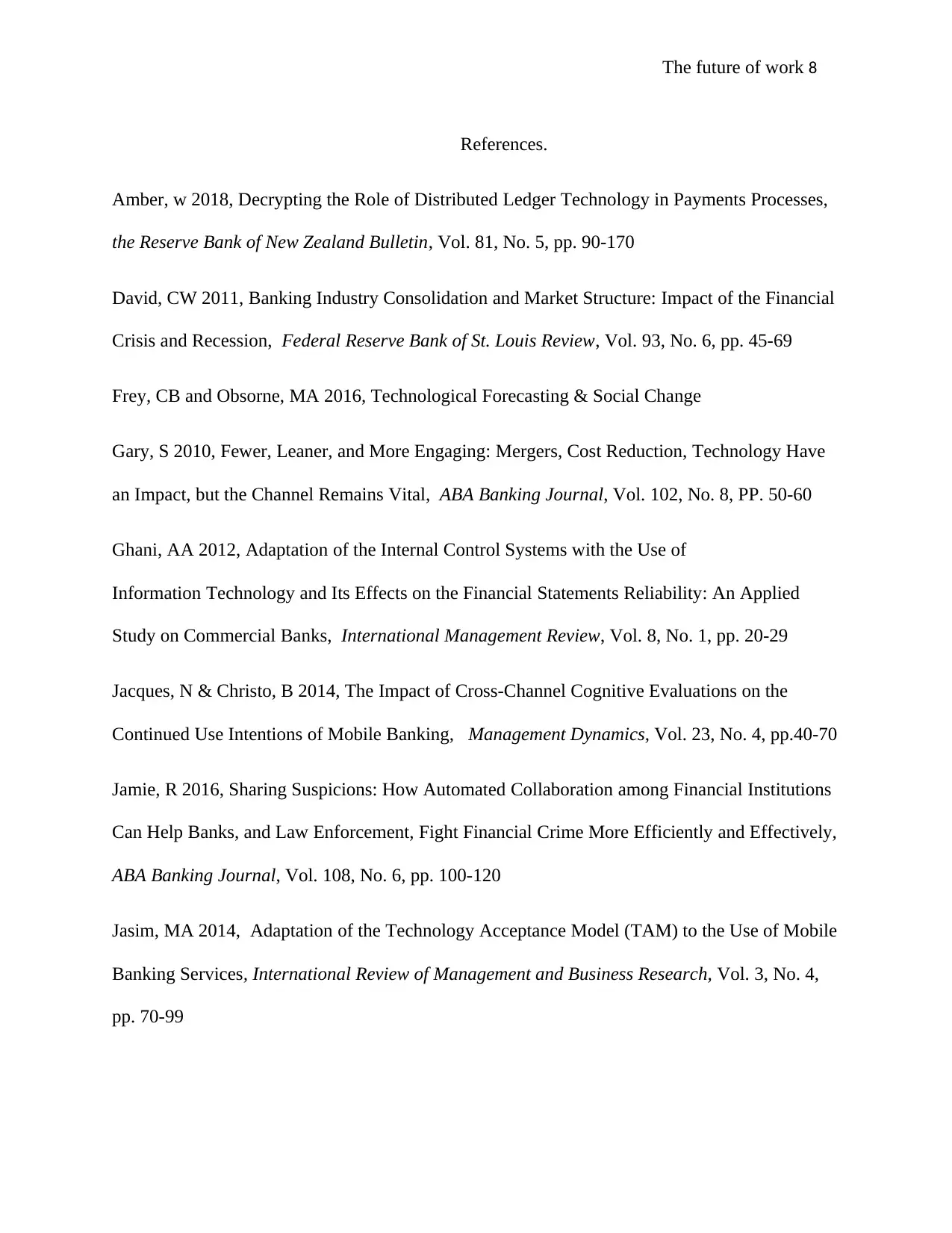
The future of work 8
References.
Amber, w 2018, Decrypting the Role of Distributed Ledger Technology in Payments Processes,
the Reserve Bank of New Zealand Bulletin, Vol. 81, No. 5, pp. 90-170
David, CW 2011, Banking Industry Consolidation and Market Structure: Impact of the Financial
Crisis and Recession, Federal Reserve Bank of St. Louis Review, Vol. 93, No. 6, pp. 45-69
Frey, CB and Obsorne, MA 2016, Technological Forecasting & Social Change
Gary, S 2010, Fewer, Leaner, and More Engaging: Mergers, Cost Reduction, Technology Have
an Impact, but the Channel Remains Vital, ABA Banking Journal, Vol. 102, No. 8, PP. 50-60
Ghani, AA 2012, Adaptation of the Internal Control Systems with the Use of
Information Technology and Its Effects on the Financial Statements Reliability: An Applied
Study on Commercial Banks, International Management Review, Vol. 8, No. 1, pp. 20-29
Jacques, N & Christo, B 2014, The Impact of Cross-Channel Cognitive Evaluations on the
Continued Use Intentions of Mobile Banking, Management Dynamics, Vol. 23, No. 4, pp.40-70
Jamie, R 2016, Sharing Suspicions: How Automated Collaboration among Financial Institutions
Can Help Banks, and Law Enforcement, Fight Financial Crime More Efficiently and Effectively,
ABA Banking Journal, Vol. 108, No. 6, pp. 100-120
Jasim, MA 2014, Adaptation of the Technology Acceptance Model (TAM) to the Use of Mobile
Banking Services, International Review of Management and Business Research, Vol. 3, No. 4,
pp. 70-99
References.
Amber, w 2018, Decrypting the Role of Distributed Ledger Technology in Payments Processes,
the Reserve Bank of New Zealand Bulletin, Vol. 81, No. 5, pp. 90-170
David, CW 2011, Banking Industry Consolidation and Market Structure: Impact of the Financial
Crisis and Recession, Federal Reserve Bank of St. Louis Review, Vol. 93, No. 6, pp. 45-69
Frey, CB and Obsorne, MA 2016, Technological Forecasting & Social Change
Gary, S 2010, Fewer, Leaner, and More Engaging: Mergers, Cost Reduction, Technology Have
an Impact, but the Channel Remains Vital, ABA Banking Journal, Vol. 102, No. 8, PP. 50-60
Ghani, AA 2012, Adaptation of the Internal Control Systems with the Use of
Information Technology and Its Effects on the Financial Statements Reliability: An Applied
Study on Commercial Banks, International Management Review, Vol. 8, No. 1, pp. 20-29
Jacques, N & Christo, B 2014, The Impact of Cross-Channel Cognitive Evaluations on the
Continued Use Intentions of Mobile Banking, Management Dynamics, Vol. 23, No. 4, pp.40-70
Jamie, R 2016, Sharing Suspicions: How Automated Collaboration among Financial Institutions
Can Help Banks, and Law Enforcement, Fight Financial Crime More Efficiently and Effectively,
ABA Banking Journal, Vol. 108, No. 6, pp. 100-120
Jasim, MA 2014, Adaptation of the Technology Acceptance Model (TAM) to the Use of Mobile
Banking Services, International Review of Management and Business Research, Vol. 3, No. 4,
pp. 70-99
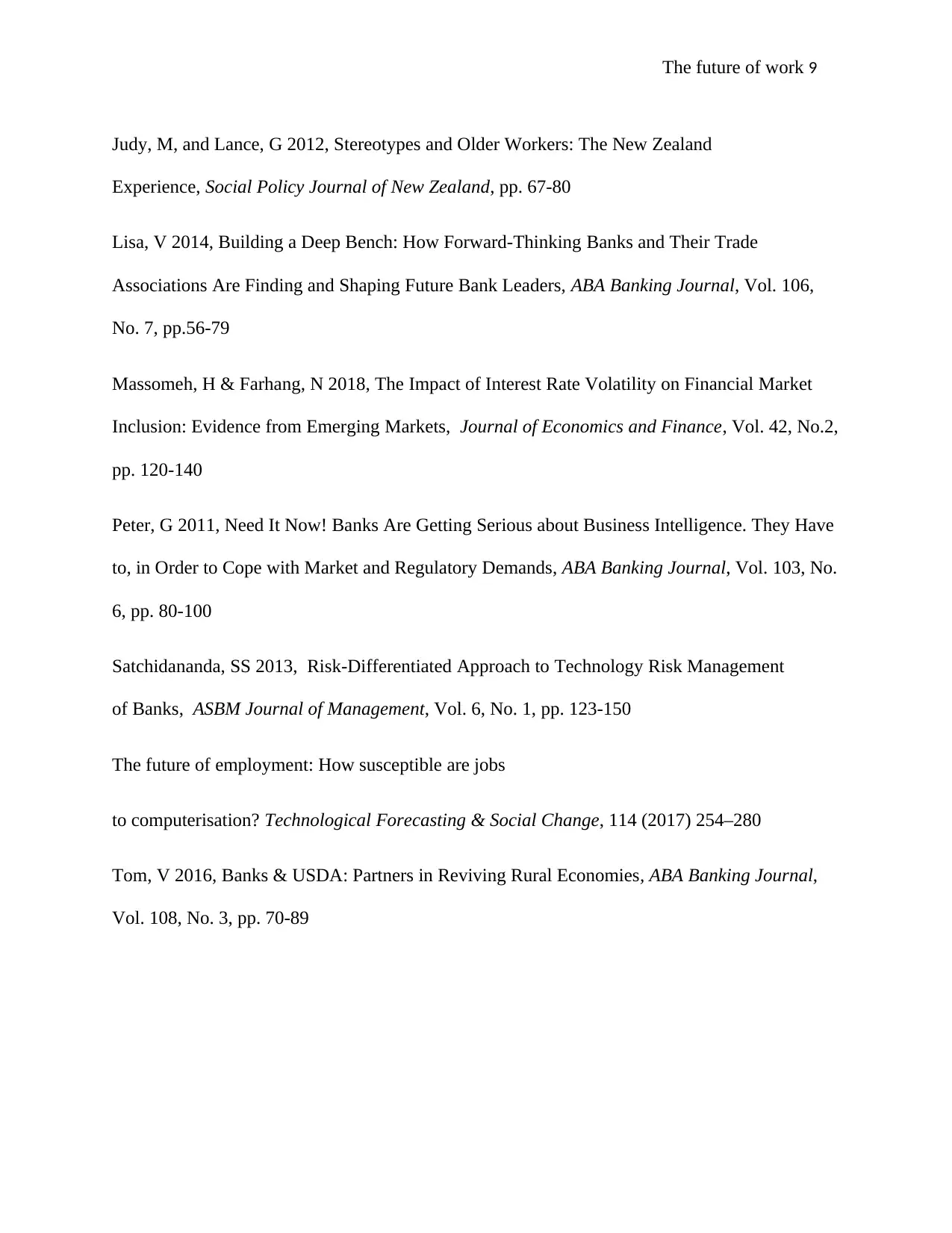
The future of work 9
Judy, M, and Lance, G 2012, Stereotypes and Older Workers: The New Zealand
Experience, Social Policy Journal of New Zealand, pp. 67-80
Lisa, V 2014, Building a Deep Bench: How Forward-Thinking Banks and Their Trade
Associations Are Finding and Shaping Future Bank Leaders, ABA Banking Journal, Vol. 106,
No. 7, pp.56-79
Massomeh, H & Farhang, N 2018, The Impact of Interest Rate Volatility on Financial Market
Inclusion: Evidence from Emerging Markets, Journal of Economics and Finance, Vol. 42, No.2,
pp. 120-140
Peter, G 2011, Need It Now! Banks Are Getting Serious about Business Intelligence. They Have
to, in Order to Cope with Market and Regulatory Demands, ABA Banking Journal, Vol. 103, No.
6, pp. 80-100
Satchidananda, SS 2013, Risk-Differentiated Approach to Technology Risk Management
of Banks, ASBM Journal of Management, Vol. 6, No. 1, pp. 123-150
The future of employment: How susceptible are jobs
to computerisation? Technological Forecasting & Social Change, 114 (2017) 254–280
Tom, V 2016, Banks & USDA: Partners in Reviving Rural Economies, ABA Banking Journal,
Vol. 108, No. 3, pp. 70-89
Judy, M, and Lance, G 2012, Stereotypes and Older Workers: The New Zealand
Experience, Social Policy Journal of New Zealand, pp. 67-80
Lisa, V 2014, Building a Deep Bench: How Forward-Thinking Banks and Their Trade
Associations Are Finding and Shaping Future Bank Leaders, ABA Banking Journal, Vol. 106,
No. 7, pp.56-79
Massomeh, H & Farhang, N 2018, The Impact of Interest Rate Volatility on Financial Market
Inclusion: Evidence from Emerging Markets, Journal of Economics and Finance, Vol. 42, No.2,
pp. 120-140
Peter, G 2011, Need It Now! Banks Are Getting Serious about Business Intelligence. They Have
to, in Order to Cope with Market and Regulatory Demands, ABA Banking Journal, Vol. 103, No.
6, pp. 80-100
Satchidananda, SS 2013, Risk-Differentiated Approach to Technology Risk Management
of Banks, ASBM Journal of Management, Vol. 6, No. 1, pp. 123-150
The future of employment: How susceptible are jobs
to computerisation? Technological Forecasting & Social Change, 114 (2017) 254–280
Tom, V 2016, Banks & USDA: Partners in Reviving Rural Economies, ABA Banking Journal,
Vol. 108, No. 3, pp. 70-89
⊘ This is a preview!⊘
Do you want full access?
Subscribe today to unlock all pages.

Trusted by 1+ million students worldwide
1 out of 9
Your All-in-One AI-Powered Toolkit for Academic Success.
+13062052269
info@desklib.com
Available 24*7 on WhatsApp / Email
![[object Object]](/_next/static/media/star-bottom.7253800d.svg)
Unlock your academic potential
Copyright © 2020–2025 A2Z Services. All Rights Reserved. Developed and managed by ZUCOL.

